Category: Cabin & deck gear
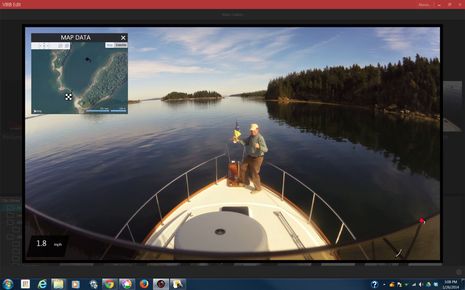 I think that Garmin hit a home run with the VIRB action cameras they began shipping last Fall. I’ve been testing the regular model since late September and the Elite model since mid December, and I can picture all sorts of enjoyable ways to use either around a boat. I’m documenting a minor cruising adventure in the scene above, but could be remote controlling the camera to capture my crew and I playing a big fish or rounding a racing mark. However, I’ve also come to think of the entire “action camera” concept as a bit of a misnomer…
I think that Garmin hit a home run with the VIRB action cameras they began shipping last Fall. I’ve been testing the regular model since late September and the Elite model since mid December, and I can picture all sorts of enjoyable ways to use either around a boat. I’m documenting a minor cruising adventure in the scene above, but could be remote controlling the camera to capture my crew and I playing a big fish or rounding a racing mark. However, I’ve also come to think of the entire “action camera” concept as a bit of a misnomer…
 Iris Innovations used some magnet magic to highlight the sveltness of the NightRunner dual payload pan/tilt/zoom navigation camera system it debuted in Fort Lauderdale. The real magic, though, seems to be in the pricing. At about $5,000 including a full-featured joystick control pad, the NightRunner isn’t that much more than a fixed Raymarine T200 with the same 320 x 240 thermal resolution and no daylight camera at all, and the NightRunner installation doesn’t seem much harder. Meanwhile the dual payload PTZ model most similar to the NightRunner appears to be the FLIR M-324L (or its sibling Ray T400) with a full retail price of about $15,000! How is this possible?
Iris Innovations used some magnet magic to highlight the sveltness of the NightRunner dual payload pan/tilt/zoom navigation camera system it debuted in Fort Lauderdale. The real magic, though, seems to be in the pricing. At about $5,000 including a full-featured joystick control pad, the NightRunner isn’t that much more than a fixed Raymarine T200 with the same 320 x 240 thermal resolution and no daylight camera at all, and the NightRunner installation doesn’t seem much harder. Meanwhile the dual payload PTZ model most similar to the NightRunner appears to be the FLIR M-324L (or its sibling Ray T400) with a full retail price of about $15,000! How is this possible?
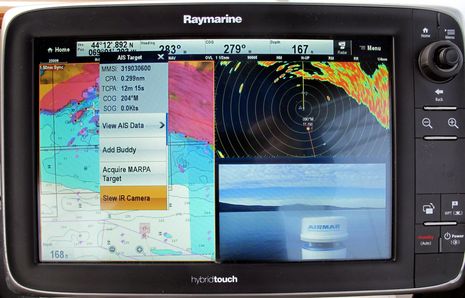 I’ve long thought that the usefulness of a navigation camera would increase significantly with tight integration to a boat’s principal navigation system, and now I’m convinced. When I redid Gizmo’s antenna mast last spring, I got to top it off with a powerful FLIR M-618CS dual camera system that was sometimes very handy as I cruised up the coast. But when I finally got around to integrating it with the Raymarine e-127 above, its safety value took a quantum leap. While it’s obvious from the lower-right camera window that this particular test day was very clear, also obvious to me was the camera system’s potential when I can make it quickly pan and tilt to any spot on the chart screen, on which it will stay locked no matter how Gizmo manuevers and — in the case of MARPA and AIS targets — regardless of how the target moves…
I’ve long thought that the usefulness of a navigation camera would increase significantly with tight integration to a boat’s principal navigation system, and now I’m convinced. When I redid Gizmo’s antenna mast last spring, I got to top it off with a powerful FLIR M-618CS dual camera system that was sometimes very handy as I cruised up the coast. But when I finally got around to integrating it with the Raymarine e-127 above, its safety value took a quantum leap. While it’s obvious from the lower-right camera window that this particular test day was very clear, also obvious to me was the camera system’s potential when I can make it quickly pan and tilt to any spot on the chart screen, on which it will stay locked no matter how Gizmo manuevers and — in the case of MARPA and AIS targets — regardless of how the target moves…
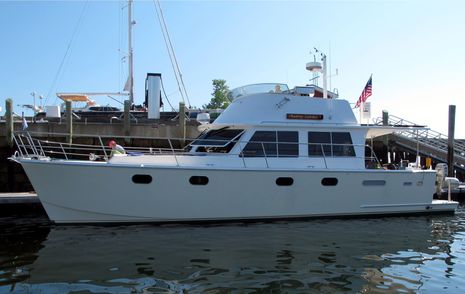 A handsome addittion to Camden Harbor recently has been the latest launch of the power catamaran design that was almost Gizmo, and darned if it doesn’t have a certain gizmological flare. Check the high-low combination of solid state and magnetron radars, for instance. In fact, the gadget-loving owner, Brian Strong, is a regular Panbo reader and he wrote up an interesting explanation of his electronics choices…
A handsome addittion to Camden Harbor recently has been the latest launch of the power catamaran design that was almost Gizmo, and darned if it doesn’t have a certain gizmological flare. Check the high-low combination of solid state and magnetron radars, for instance. In fact, the gadget-loving owner, Brian Strong, is a regular Panbo reader and he wrote up an interesting explanation of his electronics choices…
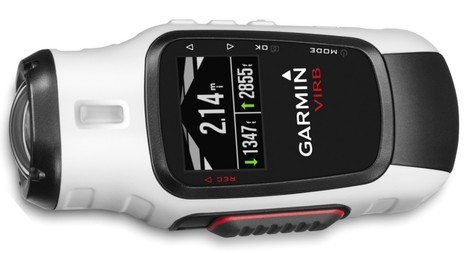 Yesterday Garmin big-footed into a new niche with new VIRB action cameras — VIRB as in verb, as in action (I think). It’s not a boat camera per se, but I expect that one will be useful and fun around a boat, and it’s also another indication of the company’s product ‘ecosystem’ stradegy. Garmin was just getting into dedicated marine electronics when I began covering the subject in depth over a decade ago, but nonetheless the major players almost unanimously cited the big Kansas complex full of engineers (with its own factory in Taiwan) as their biggest competitive fear. I suspect it was capablities like this that caused the concern. VIRB is not an assault on any marine companies but CNet’s sharp analysis is aptly titled “Garmin gets up in GoPro’s grill with VIRB HD cameras“…
Yesterday Garmin big-footed into a new niche with new VIRB action cameras — VIRB as in verb, as in action (I think). It’s not a boat camera per se, but I expect that one will be useful and fun around a boat, and it’s also another indication of the company’s product ‘ecosystem’ stradegy. Garmin was just getting into dedicated marine electronics when I began covering the subject in depth over a decade ago, but nonetheless the major players almost unanimously cited the big Kansas complex full of engineers (with its own factory in Taiwan) as their biggest competitive fear. I suspect it was capablities like this that caused the concern. VIRB is not an assault on any marine companies but CNet’s sharp analysis is aptly titled “Garmin gets up in GoPro’s grill with VIRB HD cameras“…
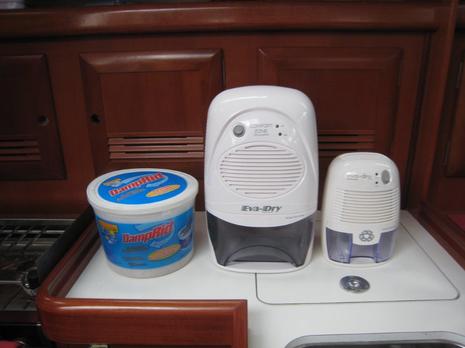 One of the products above has proven itself a far superior option in keeping my 39-foot sailboat pleasantly dry and odor free, despite an occasional need to close up the boat with wet sails or gear down below.
One of the products above has proven itself a far superior option in keeping my 39-foot sailboat pleasantly dry and odor free, despite an occasional need to close up the boat with wet sails or gear down below.
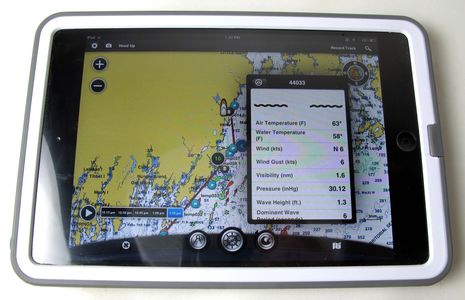
I’ve been testing three waterproof iPad cases that all have “Life” in their name for some reason (anyone?). Frankly, none got me excited until I recently snapped my iPad mini in the Lifeproof frē case above (running Garmin BlueChart Mobile). The design is stellar, I think. The LifeProof is so light and snug that the mini still feels mini, but it now has has a protective rubbery edge and non-slip back and it survived 30 minutes submerged in my sink though all the buttons plus the charge port still work fine. I suspect I’ll always use this case on the boat, and maybe everywhere. But that’s not to say that I know everything about the ever-changing world of pad cases. Let’s review the testing and discuss…
That screen above makes me so happy! I had been reluctant to give up on Gizmo’s standalone tank monitoring system but circumstances forced a change. Had I realized how easy and relatively inexpensive it...
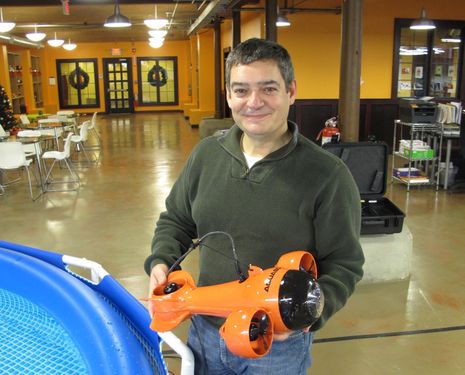
I believe that this gentleman — Durval Tavares, the founder and president of Aquabotix — earned that grin the hard way. It’s no surprise that getting something as complex as a “remote controlled underwater camera vehicle” with an iPad interface to market would be a challenge, but when I visited the company HQ yesterday I was impressed with just how many details and disciplines are in play behind the scenes. I was also impressed with the cheerful, collaborative work environment Tavares and his team have created and I quite enjoyed taking my first HydroView driving lesson in the factory test pool (video example here)…
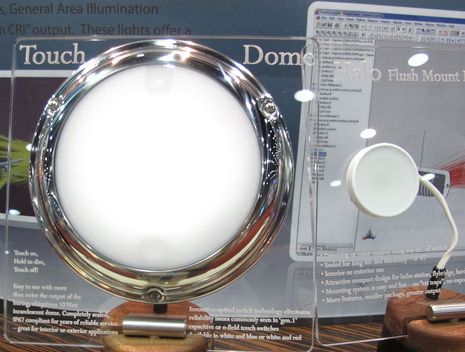
While I once again found IBEX rich with interesting people and products, it was a mere light fixture that may have sparked the moment of maximum excitement! Please check out my April entry about perfect LED interior lighting before we take a gander at the new Lumitec Touch Dome seen above, plus a report on the LED’s already in use on Gizmo…
 I think that Garmin hit a home run with the VIRB action cameras they began shipping last Fall. I’ve been testing the regular model since late September and the Elite model since mid December, and I can picture all sorts of enjoyable ways to use either around a boat. I’m documenting a minor cruising adventure in the scene above, but could be remote controlling the camera to capture my crew and I playing a big fish or rounding a racing mark. However, I’ve also come to think of the entire “action camera” concept as a bit of a misnomer…
I think that Garmin hit a home run with the VIRB action cameras they began shipping last Fall. I’ve been testing the regular model since late September and the Elite model since mid December, and I can picture all sorts of enjoyable ways to use either around a boat. I’m documenting a minor cruising adventure in the scene above, but could be remote controlling the camera to capture my crew and I playing a big fish or rounding a racing mark. However, I’ve also come to think of the entire “action camera” concept as a bit of a misnomer… 
















